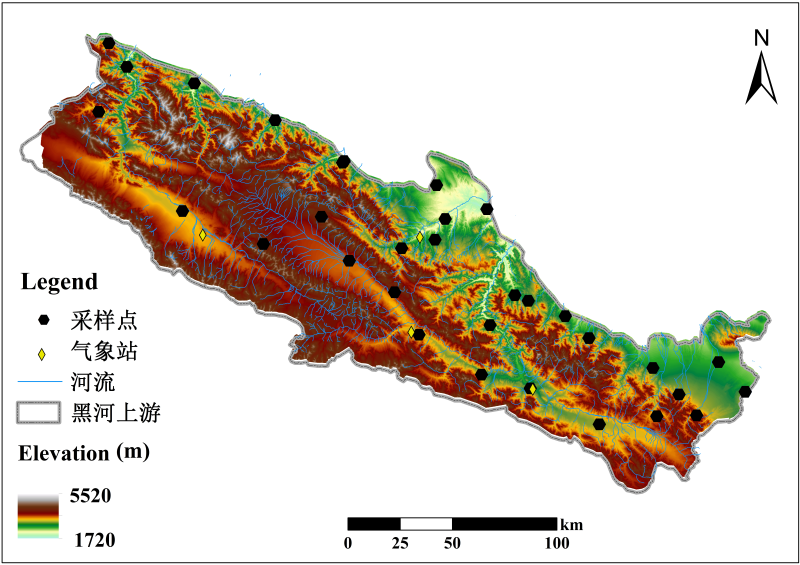Field soil survey and analysis data in the upper reaches of Heihe River Basin (2013-2014)

The dataset is the field soil measurement and analysis data of the upstream of Heihe River Basin from 2013 to 2014, including soil particle analysis, water characteristic curve, saturated water conductivity, soil porosity, infiltration analysis, and soil bulk density
I. Soil particle analysis
1. The soil particle size data were measured in the particle size laboratory of the Key Laboratory of the Ministry of Education, West Ministry of Lanzhou University.The measuring instrument is Marvin laser particle size meter MS2000.
2. Particle size data were measured by laser particle size analyzer.As a result, sample points with large particles cannot be measured, such as D23 and D25 cannot be measured without data.Plus partial sample missing.
Ii. Soil moisture characteristic curve
1. Centrifuge method: The unaltered soil of the ring-cutter collected in the field was put into the centrifuge, and the rotor weight of each time was measured with the rotation speed of 0, 310, 980, 1700, 2190, 2770, 3100, 5370, 6930, 8200 and 11600 respectively.
2. The ring cutter is numbered from 1 to the back according to the number. Since three groups are sampled at different places at the same time, in order to avoid repeated numbering, the first group is numbered from 1, the second group is numbered from 500, and the third group is numbered from 1000.It's consistent with the number of the sampling point.You can find the corresponding number in the two Excel.
3. The soil bulk density data in 2013 is supplementary to the sampling in 2012, so the data are not available at every point.At the same time, the soil layer of some sample points is not up to 70 cm thick, so the data of 5 layers cannot be taken. At the same time, a large part of data is missing due to transportation and recording problems.At the same time, only one layer of data is selected by random points.
4. Weight after drying: The drying weight of some samples was not measured due to problems with the oven during the experiment.
3. Saturated water conductivity of soil
1. Description of measurement method: The measurement method is based on the self-made instrument of Yiyanli (2009) for fixing water hair.The mariot bottle was used to keep the constant water head during the experiment.At the same time, the measured Ks was finally converted to the Ks value at 10℃ for analysis and calculation.Detailed measurement record table refer to saturation conductivity measurement description.K10℃ is the data of saturated water conductivity after conversion to 10℃.Unit: cm/min.
2. Data loss explanation: The data of saturated water conductivity is partly due to the lack of soil samples and the insufficient depth of the soil layer to obtain the data of the 4th or 5th layer
3. Sampling time: July 2014
4. Soil porosity
1. Use bulk density method to deduce: according to the relationship between soil bulk density and soil porosity.
2. The data in 2014 is supplementary to the sampling in 2012, so the data are not available at every point.At the same time, the soil layer of some sample points is not up to 70 cm thick, so the data of 5 layers cannot be taken. At the same time, a large part of data is missing due to transportation and recording problems.At the same time, only one layer of data is selected by random points.
5. Soil infiltration analysis
1. The infiltration data were measured by the "MINI DISK PORTABLE specific vector INFILTROMETER".The approximate saturation water conductivity under a certain negative pressure is obtained.The instrument is detailed in website: http://www.decagon.com/products/hydrology/hydraulic-conductivity/mini-disk-portable-tension-infiltrometer/
2.D7 infiltration tests were not measured at that time because of rain.
Vi. Soil bulk density
1. The bulk density of soil in 2014 refers to the undisturbed soil taken by ring cutter based on the basis of 2012.
2. The soil bulk density is dry soil bulk density, which is measured by drying method.The undisturbed ring-knife soil samples collected in the field were kept in an oven at 105℃ for 24 hours, and the dry weight of the soil was divided by the soil volume (100 cubic centimeters).
3. Unit: G /cm3
Copyright & License
. xlsx format storage
Data Citations
Cite as:He, C. (2016). < b>Field soil survey and analysis data in the upper reaches of Heihe River Basin (2013-2014)</b>2016. doi: 10.3972/westdc.x.2013.db. (Download the reference: RIS | Bibtex )
Using this data, the data citation is required to be referenced and the related literatures are suggested to be cited.
Terms of Use
To respect the intellectual property rights, protect the rights of data authors, expand services of the data center, and evaluate the application potential of data, data users should clearly indicate the source of the data and the author of the data in the research results generated by using the data (including published papers, articles, data products, and unpublished research reports, data products and other results). For re-posting (second or multiple releases) data, the author must also indicate the source of the original data.
Related Resources
1.The leaf water potential dataset in the downstream of the Heihe River Basin (2012)
2.HiWATER: Dataset of infrared temperature in Zhanye Airport desert
4.The boundary of Heihe River Basin (1985)
7.The soil heat flux dataset in the lower reaches of Heihe River (2011-2013)
8.The monitoring data of the groundwater level in the middle of Heihe River basin (2005-2007)
No record
No record
Comments
Sign In to add comments
Keywords
Geographic coverage
| Spatial coverage |
East:101.5 South:37.7 |
West:97.5 North:39.6 |
|---|
Details
- Format: 栅格
- File size: 6.05 MB
- Browse count:11323
- Temporal coverage:2013-01-12 To 2015-01-11
- Access: Offline
- Updated time:2021-04-19
Authors
Resource Provider: HE Chansheng

 Copyright ©right; 2017 - 中国科学院西北生态环境资源研究院 - 兰州数云软件科技有限公司提供技术支持
Copyright ©right; 2017 - 中国科学院西北生态环境资源研究院 - 兰州数云软件科技有限公司提供技术支持